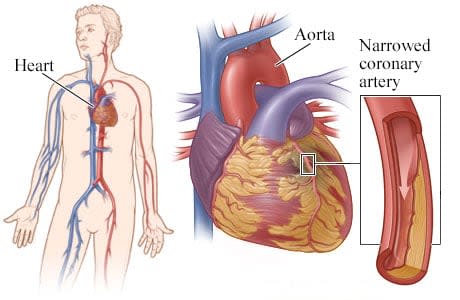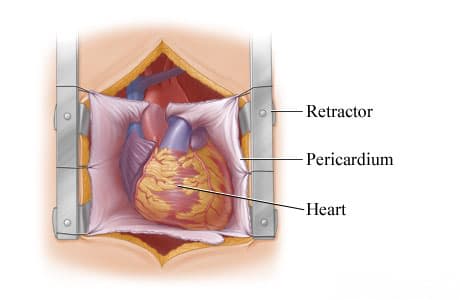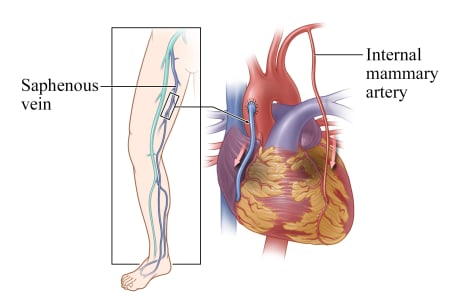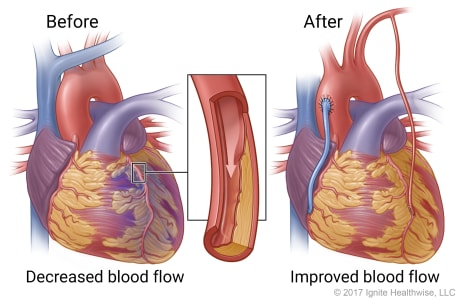Our Health Library information does not replace the advice of a doctor. Please be advised that this information is made available to assist our patients to learn more about their health. Our providers may not see and/or treat all topics found herein. Coronary artery bypass graft (CABG) surgery is used to treat coronary artery disease. It helps blood flow around, or bypass, one or more narrowed or blocked coronary arteries. The arteries may have plaque buildup (atherosclerosis). These arteries are the blood vessels that bring blood to the heart muscle. This surgery is also called bypass surgery. Your doctor will make the bypass with a healthy piece of blood vessel from another part of your body. Then the doctor will attach, or graft, the healthy blood vessel above and below the narrowed or blocked artery. Blood is redirected through the new blood vessel. This restores blood flow to the affected portion of the heart muscle. The doctor usually makes a cut in the skin over your breastbone (sternum). This cut is called an incision. Then the doctor will cut through your sternum to reach your heart and coronary arteries. A heart-lung bypass machine is usually used during the surgery to add oxygen to the blood and move the blood through the body. The doctor will use blood vessels from your chest, arm, or leg to bypass the narrowed or blocked parts of your arteries. In some cases, the doctor may be able to do the surgery without using a heart-lung machine. This is called "off-pump" surgery. The doctor may use wire to put your sternum back together. Stitches or staples will be used to close the incisions in the skin over your sternum and the arm or leg where your healthy blood vessel was taken. The wire will stay in your chest. The incisions will leave scars that may fade with time. You will stay in the hospital for a few days after surgery. You will probably be able to do many of your usual activities after 4 to 6 weeks. But for at least 6 weeks you will avoid lifting heavy objects and doing things that strain your chest or upper arm muscles. At first you may notice that you get tired quickly. You may need to rest often. It may take 1 to 2 months before your energy is back to normal. Coronary artery bypass graft surgery redirects blood around narrowed or blocked arteries, increasing blood flow to the heart muscle. Bypass surgery is most often done as an open-heart surgery. The surgeon makes a vertical incision in the skin and muscle in the middle of the chest and then cuts through the breastbone (sternum). The surgeon spreads the rib cage with a retractor to expose the heart and then cuts through the lining that protects the heart (pericardium). To redirect blood flow around the narrowed or blocked arteries, the surgeon uses a healthy piece of blood vessel taken from another part of your body. For example, the saphenous vein from the leg or an internal mammary artery from the chest may be used. Blood is redirected through the new blood vessel. This restores blood flow to the affected portion of the heart muscle. You will go to the intensive care unit (ICU) after surgery. You will probably stay in the ICU for 1 or 2 days before you go to your regular hospital room. In the ICU, you will likely have: Many of these monitoring devices are usually removed within a few days of surgery. You will stay in the hospital for at least a few days after the surgery. You will feel tired and sore for the first few weeks. Your chest, shoulders, and upper back may ache. These symptoms usually get better in 4 to 6 weeks. It may take 1 to 2 months before your energy level is back to normal. You may have some swelling or pain in the area where the healthy blood vessel used for the bypass was taken. You will probably be able to do many of your usual activities after 4 to 6 weeks. But for at least 6 weeks, you'll avoid lifting heavy objects and doing activities that strain your chest or upper arm muscles. After surgery, follow a heart-healthy lifestyle. This lifestyle can help lower your risk of a heart attack or stroke or other heart problems. It also can help the bypass graft last as long as possible. To have a heart-healthy lifestyle: Smoking or vaping can make it harder for you to recover. It will raise the risk of your arteries getting narrowed or blocked again. If you need help quitting, talk to your doctor about quit programs and medicines. These can increase your chances of quitting for good. Secondhand smoke and vaping mist can also increase your risk for problems. You may start a cardiac rehabilitation (rehab) program in the hospital. This program will continue after you go home. It will help you recover. And it can prevent future problems with your heart. Bypass surgery is done to treat a heart attack and coronary artery disease. Surgery might be an option for many reasons. These reasons include the following: Whether surgery is an option for you also depends on your age, your health, and how much your symptoms are affecting your quality of life. Your doctor is likely to recommend bypass surgery only if you will benefit from it and if those benefits are greater than the risks. You and your doctor can work together to decide if you want to have surgery. Bypass surgery: The risks during or soon after bypass surgery include: The chances of having a serious problem with bypass surgery increase with age. Your risk is also higher if you have other problems such as diabetes, kidney disease, lung disease, or peripheral arterial disease. Your doctor can help you understand what your risk for problems is. Current as of: October 2, 2025 Author: Ignite Healthwise, LLC Staff Current as of: October 2, 2025 Author: Ignite Healthwise, LLC Staff Clinical Review Board This information does not replace the advice of a doctor. Ignite Healthwise, LLC disclaims any warranty or liability for your use of this information. Your use of this information means that you agree to the Terms of Use and Privacy Policy. Learn how we develop our content. To learn more about Ignite Healthwise, LLC, visit webmdignite.com. © 2024-2025 Ignite Healthwise, LLC.Topic Contents
Coronary Artery Bypass Graft Surgery
How It Is Done





What To Expect
Right after surgery
Recovery
Learn more
Why It Is Done
How Well It Works
Risks
Credits
Clinical Review Board
All Ignite Healthwise, LLC education is reviewed by a team that includes physicians, nurses, advanced practitioners, registered dieticians, and other healthcare professionals.
All Ignite Healthwise, LLC education is reviewed by a team that includes physicians, nurses, advanced practitioners, registered dieticians, and other healthcare professionals.
Our Health Library information does not replace the advice of a doctor. Please be advised that this information is made available to assist our patients to learn more about their health. Our providers may not see and/or treat all topics found herein. Current as of: October 2, 2025 Author: Ignite Healthwise, LLC Staff Clinical Review BoardCoronary Artery Bypass Graft Surgery
All Ignite Healthwise, LLC education is reviewed by a team that includes physicians, nurses, advanced practitioners, registered dieticians, and other healthcare professionals.



